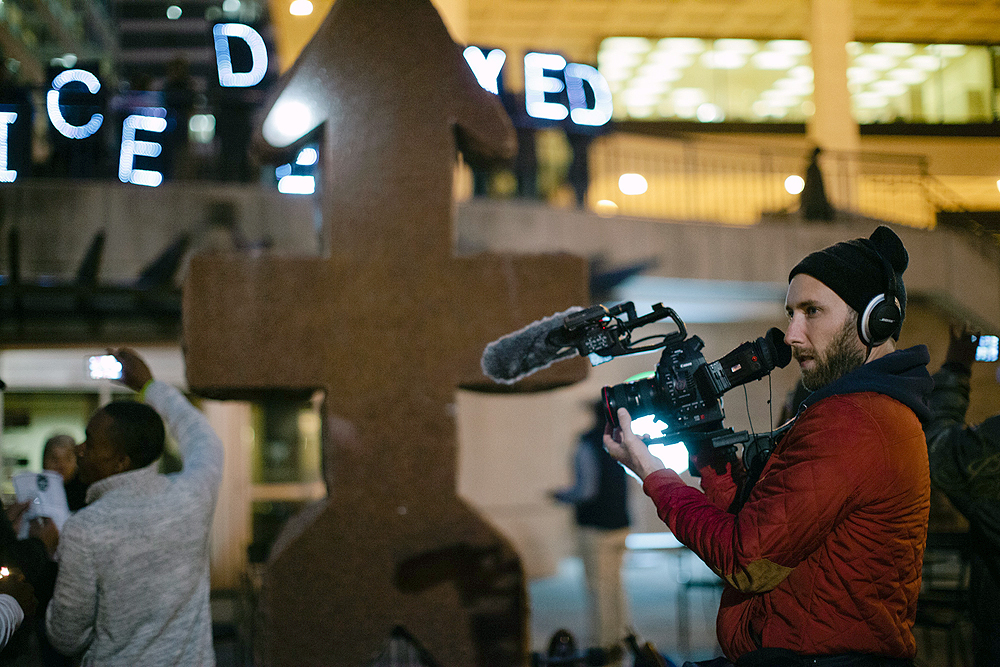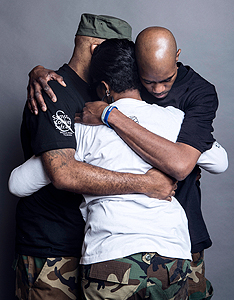
Dontre Hamilton Family Holds Candlelight Vigil. Picture by Jennifer Johnson for THE BLOOD IS AT THE DOORSTEP
Update June 6: The City of Milwaukee reached a $2.3 million settlement with the family of Dontre Hamilton, which will go to his only living son once he becomes an adult. In a press conference following the announcement, Maria Hamilton said “This is not a victory. This is not the justice that me and my family wanted.”
On April 30, 2014, Dontre Hamilton, 31, an unarmed black man diagnosed with schizophrenia, was shot 14 times and killed by a Milwaukee police officer in a downtown park and in broad daylight. His death sparked months of unrest and his death and aftermath can still get front page and headline news in Wisconsin’s biggest city.
THE BLOOD IS AT THE DOORSTEP combines the spirit and techniques of ethnography, investigative journalism and, of course, documentary filmmaking for a story that soars like an epic narrative. It is passionately told yet eschews the Sturm und Drang of a protest movie (this writer has no problems with protest movies) and is as impartial as the best of journalistic-documentaries can be. The film shows the institutional racism as well as the archaic traditions of the police and criminal justice system in Milwaukee in the course of its 90 minutes.
It’s cinematic sweep and style also show the raw dimensions of a divided community. Its sweep is so broad and its narrative so well done, in fact, that it caused this writer to recall the documented truth and reconciliation and peace efforts that occurred in countries like South Africa, with the defeat of its apartheid system, and Ireland bringing an end to its Troubles.
THE BLOOD IS AT THE DOORSTEP, scheduled for upcoming public screenings June 9 and 10. It runs 98 minutes and was directed by Erik Ljung.
Erik ljung – Director, Producer, Director of Photography
Michael T. Vollman, Editor
Daniel T. Peters, Cinematographer
www.thebloodisatthedoorstep.tv
Erik Ljung was asked, of course, how he came to make his movie.
“Well, I work as a freelance DP and video journalist in general, and I’ve covered a lot of stories in Milwaukee, so I was pretty tied into the activist communities there. This incident happened about a mile from my house where I lived at the time, and still live. It happened in the most populated, downtown area of Milwaukee. Dontre was an unarmed guy. The police officers were responding to a non-emergency wellness check and he was shot 14 times. It just didn’t make sense to me, so as soon as it happened, I was following it very closely in the news. That was a big part of it.”
“I was just trying to figure out what happened and trying to understand from the family’s perspective because I saw the narrative that was put forth by police and I saw the things that people were saying about this family in the media – especially these things like people saying the family didn’t care about Dontre and calling him homeless and that this family’s just seeing an opportunity to cash in.”
“This happened before Ferguson, and so my focus at the time was through a mental health lens, because my own family has struggled with mental health issues, with a cousin that I grew up with, with paranoid schizophrenia and is homeless in my hometown in California. When I saw people disparaging the Hamilton family online, I understood it’s a lot more complicated then a black or white issue, like your family that cares or doesn’t care about you and dealing with an adult family member with a mental health issue is very difficult.”
“That’s where it started and another big reason starting this film as well was the Michael Bell law that had recently passed in Wisconsin and so, this was the very first case in the country to fall under a mandatory outside investigation law in an officer-related death.” [Michael Bell Law]
“I thought the Dontre case would be an interesting litmus test of a law like this, and if it could be implemented outside of that. Then when Ferguson broke and police shootings became kind of a mainstay in the news cycles, the film kind of took on a new life. The focus maybe shifted a little bit.”
Ljung was asked what he expected expect the reaction to be in Milwaukee where the film has yet to be shown? He shared some anecdotes.
“I did a 10-minute video piece for the New York Times and interviewed the police chief for that, and I know the chief wasn’t too happy with how he felt he was portrayed in that. To be honest, the Hamilton family wasn’t very happy with the New York Times piece either because they felt I gave so much screen time to the police department. I don’t know, I felt it was fair. Actually, the police department still gave me access after the New York Times piece came out … so they couldn’t have been too upset by it. [Ljung’s New York Times “Police Shooting Tests New Wisconsin Law” ]
He said there was a sharp flareup between a community activist involved in the movement for justice and the Hamiltons. But on the day that the “DA, when he announces the decision [not to charged the police officer with homicide],” the activist “was on stage with the family at the podium” in support. “That’s something we’re putting back in just to show that Kaleel, despite everything, everyone was still on the same team, despite behind-the scenes-disagreements.”
“I’m sure a lot of people aren’t going to be happy but we didn’t make this film to make people comfortable, so it’s like there’s a lot of uncomfortable things being discussed and shown. It’s going to be controversial and people are going to be upset, but hopefully it starts some kind of a dialogue and a better understanding of what’s happening behind the scenes.”
He was asked about his next project.
Ljung said he was “part of like a collaborative team that’s working on a film” about Trump. “We’re still trying to figure out if it’s going to be a film or series, but it’s going to be about the first year of the Donald Trump presidency and all the groups that it effects, from many different angles. There’s like 15 filmmakers, spread across the country and the world.”
“We have a filmmaking team in New York, and the Midwest, and San Francisco and everyone’s kind of tied into different groups. I’ve been filming with a Syrian refugee family in Milwaukee and I’ve been filming with community activists in Milwaukee, but we’re also filming with Trump supporters as well. We’re trying to show both … all different groups’ viewpoints on the first year of a Donald Trump presidency, if he makes it a year.”
What were the challenges in making this film?
“When I started this project I didn’t really have the intention of making a feature-length documentary film. I mean, I didn’t really know what I was doing, I just know that I had to be out there and bear witness for at least a couple rallies. The more I went out there, the more I needed to know more and the more I needed to film with the family.”
“It pretty quickly became like an all-consuming thing, where I just stopped hanging out with people, and was either just freelancing or worrying about this film and what I was missing and what I needed to tell a story, and what was the Hamilton family doing and trying to do research of … it was like all I did basically, all I ever thought about and talked about for probably the last three years, and even still.”
“The biggest struggle for me was all my connections were in video journalism and not necessarily independent documentary filmmaking, so I wasn’t even aware of all the grants that you were supposed to apply for, or all the pitch forms that I should have been applying to. I was kind of like, being in Milwaukee, you don’t really have those networking opportunities to connect with the decision makers. By the time I figured out I should be applying to these things, like ITBS or all these other grants, it was like a year and a half into production.”
“I didn’t have a producer. I was producing this myself. I was the one writing grants, I was the one shooting. In the field I was shooter, director, audio person, producer, 90 percent of the time it was like a one-man band situation in the field.”
“We didn’t get a lot of funding. This was largely funded by just me hitting the road and freelancing as a director of photography on commercial shoots. I was working for Vice News a lot of the time, and I filmed some McDonald’s commercials, so it’s like these are the things that really funded the film. That gave me a lot of anxiety, as being on the road when this is like a breaking news situation. I was constantly worried about missing things. I did miss some things, but I had people … there was one guy in particular, Dan Peters, who we worked with, he was like my right-hand man, so if I was out of town, he would fill in for me and shoot and then … it was really like the team, it was essentially me, Dan Peters and Michael Vollman editing.”
“We had support beyond that, but the core team that did 95 percent of the work was just three of us. In hindsight, there’s no way I would ever make a film again without having a producer on board. And just more people with skin in the game that could vouch for the project and keep it going, and be making calls and responding to emails, because trying to do everything yourself is … I turned into a little bit of a crazy person throughout the project. I think the film could have been so much better with more people.”
“As far as being in the field, I think a lot of it was necessary to have a one man band or small crew, because we’re in very intimate, personal situations and just having more production crew would distract from that. I was in so tight with the activists and community, like everyone trusted me, so bringing more people onto that, I just think would make it more of a production.”
“Dan and Michael were both white men as well, so it’s like bringing more white guys into the situation with a family I don’t think was really necessary. In a lot of ways it helped to have a small crew, but in other ways, it definitely would have been beneficial to have a little bit more support.”
Gregg Morris can be reached at gmorris@hunter.cuny.edu


